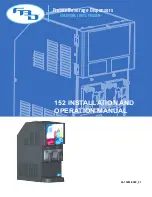
12
PROBLEM
CAUSES
SOLUTIONS
Brine tank overfills or
does not draw brine
A) Loose nut at either
end of the brine line
B) Plugged injector
C) Brine line inserted
into the brine tank
overflow fitting
rather than
connected to the
safety brine valve
D) Softener drain line
connected to brine
overflow fitting or
overflow drain line
E) Obstruction in the
control valve
F) Problems with drain
line: plugged,
frozen, kinked,
flexible tubing,
overhead
installation,
diameter too small,
longer than 15’
G) Missing BLFC
H) Missing brine stem
I)
Drive cap too loose
1) Tighten nuts at either end of brine line
2) Clean injector and injector screen
3) Verify brine line is installed correctly
4) Verify softener drain line is not connected
to brine overflow elbow or brine overflow
drain line
5) Check for debris in DLFC Assembly, BLFC
Assembly, injector, injector screen
6) Manually put softener into Backwash Cycle
(page 9, beginning with step 12) and
unplug the transformer for 30 minutes to
dislodge debris from inside the control
valve or disassemble and clean control
valve internal components
7) Resolve issues with the drain line
8) Verify brine line flow control button is not
missing
9) Verify piston brine stem is not missing
10) Tighten drive cap
Hard water or
softener not using salt
A) Electrical outlet is
dead or on a switch
B) No salt in the brine
tank
C) Salt in the brine tank
has “bridged”
D) Bypass Valve is not
in “Service” position
or is leaking
E) Obstruction in
control valve
F) Problems with drain
line: : (
See letter
“E” in prior section
)
G) Control valve
programmed
incorrectly
H) Softener sized
improperly
I)
Faulty or unplugged
drive motor
J) Meter is not
registering flow
K) Time of Day is
flashing
1) Verify softener has uninterrupted power
2) Fill brine tank with salt
3) Hit the side of the brine tank with rubber
mallet to break any bridging
4)
Verify bypass is in “Service” position
(Figure 2, Page 4)
5) Check for debris in DLFC, BLFC, injector,
injector screen, cartridge seal assembly
6) Manually put softener into Backwash Cycle
(page 9, beginning with step 11) and
unplug transformer for 20-30 minutes to
dislodge debris
7) Resolve issues with drain line
8) Review control valve programming
9) Verify actual service flow rates required and
compare to system specifications (pages
15-16)
10) Verify drive motor is connected to control
valve circuit board connector J1 (labeled
“MOTOR”)
11) Verify meter cable (grey cable, 3 pins) is
connected to control valve circuit board
connector J2
(labeled “METER”), verify
impeller spins freely and registers flow and
there are no obstructions preventing it from
spinning, replace meter if defective
12) Reset time & replace backup battery if
needed
Troubleshooting













































